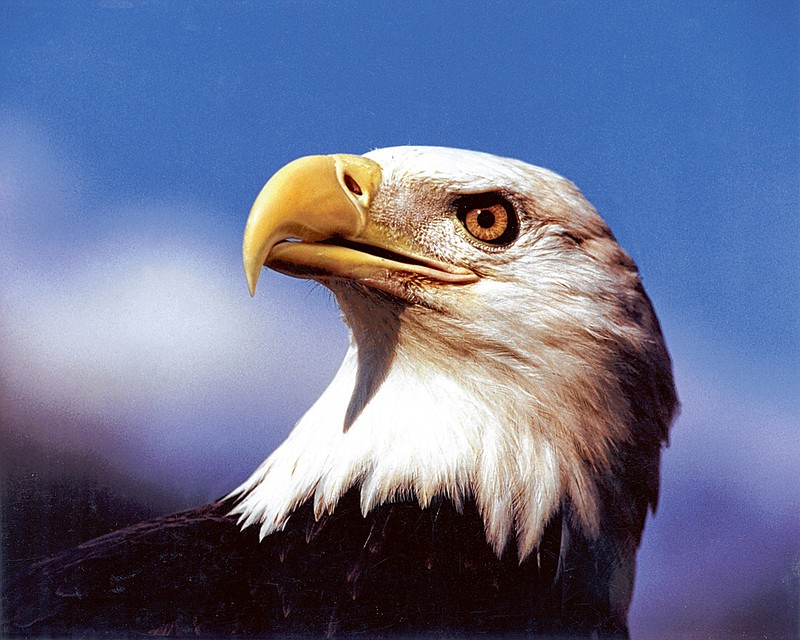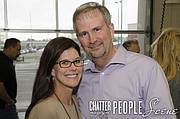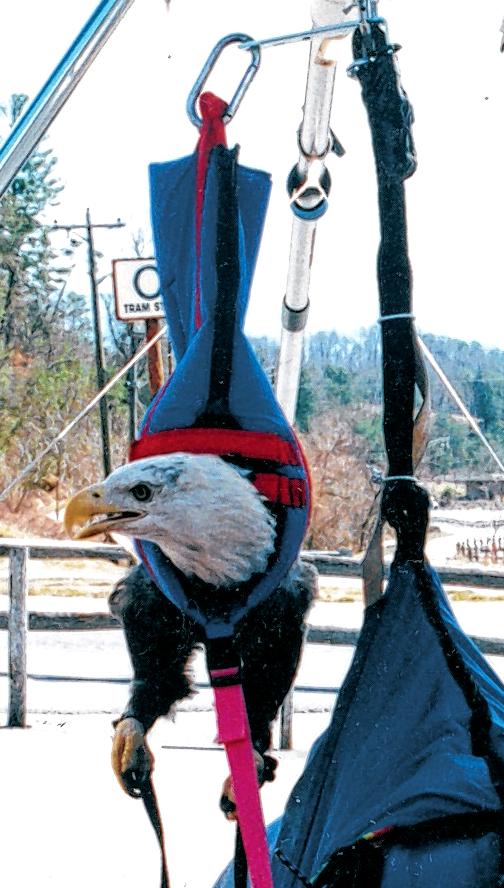When you click the video on Osceola the Hangliding Eagle's website, Mr. Mister blares out its biggest hit. "Take these broken wings, and learn to fly again, learn to live so free." Ok, so the song - in all its synthesizer-spangled glory - crosses the line on cheesy. But based on the story of Osceola and his handler, John Stokes, it couldn't be more fitting.
Osceola's broken wing came not from a heartbreaking lost love like Mr. Mister sings about, but from a bullet. The bird was found shot near Osceola, Arkansas with a badly infected left wing that would eventually have to be amputated.
Where the sad story goes on the rebound, just as the song says, is when Osceola got a chance to fly again - harnessed into Stokes' hang glider. "It's not flying as he knows it, but it's as close as I can give him," says Stokes, a Dade County, Georgia resident who has recently published a book about the adventure, "An Eagle Sky: My Life as a Birdman." The e-book ($4.99) is available for download on Smashwords. com. Stokes, who shares his hometown of New Albany, Miss., with William Faulkner, says he's been working on the book since 2001. "I'll never be a Faulkner or a Hemmingway or something like that, I just had a story to tell," he says.
While Osceola's recovery story is unusual enough to have garnered attention from "Good Morning America" and Reader's Digest, his injury is unfortunately not unique. Eagles and other birds of prey are occasionally shot, despite the threat of hefty fines and other penalties.
No witnesses have ever come forward from that day in January 1983, but Stokes imagines a rapid, wildly spiraling descent before Osceola smashed into the trees."
Just two years ago in early 2011, two dead bald eagles were found shot in the Chattanooga region, one in Cumberland County and the other in Bledsoe. Stokes says the shootings, which are not by hunters but by "idiots with a gun" are inexcusable.
"If someone is shooting at a soaring bird of prey, that's an intentional shooting," he says. "A good hunter wouldn't do that. We think somebody just saw (Osceola) in the sky and just plinked him."
No witnesses have ever come forward from that day in January 1983, but Stokes imagines a rapid, wildly spiraling descent before Osceola smashed into the trees. He believes the impact of the hard landing shattered the eagle's ultra-light left humerus.
After a week on the ground, rabbit hunters spotted the badly injured eagle. Osceola had lice and was scratched up. Gangrene had set in on the dirty wound and threatened to move up the wing into his body. "He would have been dead within three days," Stokes speculates.
The hunters called game wardens who contacted Stokes, then a zookeeper at the Memphis Zoo. In his book, Stokes doesn't sugarcoat Osceola's condition from the examination. "The wing bones crunched and ground in a sickening fashion as I felt the eagle try to flap the injured limb," he wrote.
The infection forced veterinarians to remove the wing. For the rest of his life, it seemed, Osceola was grounded.
After his surgery, there was no way Osceola could survive in the wild, so Stokes incorporated him into the zoo's educational programs. At that time, bald eagles were just starting to be reintroduced in Tennessee after the last known native eagle disappeared in 1962. For many in his audiences, Osceola was the first eagle they had even seen in person. "We've had people cry and others applaud," Stokes describes. "You never know who you're going to influence."
And while Osceola was the undisputed star of the show, Stokes has proven to be a capable partner. In his 35 years with birds, Stokes has worked with everything from hummingbirds to ostriches. He and his wife, Dale Kernahan, are now co-directors of Save Our American Raptors and run the Rock City Raptors bird show at Rock City in the summer.
Bald Eagle BasicsAfter reaching dangerously low population levels, bald eagles now have a presence in every U.S. state, except Hawaii.There are estimated to be more than 10,000 nesting pairs in the lower 48 states now.Bald eagles can have a wing span up to eight feet and can weigh up to 15 pounds.Officially declared the National Emblem of the United States by the Second Continental Congress in 1782.Diving speed is estimated at 75 to 100 miles per hour.They can fly to altitudes of 10,000 feet or more.From the American Eagle Foundation.Learn more at eagles.org.
Flying - be it birds or humans - has been a big part of his life since childhood. In the early 1960s, when he was four or five years old, Stokes started watching the television show "Ripcord," which featured skydivers dropping from their parachutes just in time to foil the bad guys or prevent a calamity. The men floating through the air was so fascinating, Stokes decided to try it himself. He climbed a sweetgum tree with a bed sheet and took a leap, expecting the sheet to fill with air and lower him gently back to Earth. Instead, he was immediately met by the whacks of the tree branches. Luckily, he got stuck in the limbs before he hit the ground. "I was introduced to three things that day: gravity, sudden deceleration and my guardian angel," jokes Stokes.
He caught the hang-gliding bug at Memphis State (now the University of Memphis) when he found some gliding magazines in the library. Without ever seeing a rig in person, he bought a glider and was soon meeting up with other pilots to jump off of any hill they could find. Eventually, he started making trips to hang-gliding hotspots on Raccoon and Lookout mountains and the Sequatchie Valley.
In his book he recalls his first flight: "Time was altered. What seemed like a thirty-second flight was only about six seconds long. I landed on my feet. I unhooked from the glider and started jumping up and down like Daffy Duck."
Lift Off
It was only a matter of time before Stokes brought hang gliding and his work with raptors together with an idea in April 1984. Driving home from a program, Stokes began thinking of a California glider pilot named Burke Ewing who had devised a harness so his dog, Curtis, could glide with him. "If a man could fly with a dog, why can't someone construct a harness and fly with an eagle?" Stokes wrote.
It took some experimentation to get the harness right, but as soon as he and Osceola were satisfied with it, they began ground testing. Any activities involving eagles must be OK'ed by the U.S. Fish and Wildlife Service but against the odds, the agency approved the mission. With a permit in hand and testing complete, Stokes took the bird to Lookout Mountain Flight Park where he and Osceola were aerotowed into the sky. "Once we got above the trees he started looking around, he was fascinated," Stokes remembers.
The pilot acknowledges that the first flight was a risk - sharp talons shredding the glider would have put an abrupt end to the flight. He expected Osceola to stay calm, but there was a chance something could go wrong. The flight was flawless, including the highlight, when a pair of red-tailed hawks passed below the glider. "Perhaps, it was at this point that Osceola realized that he was in the sky again," Stokes wrote. "For so many years, he could only look up at soaring hawks. Now, he was looking at the tops of their wings."
The two spent hours in the air on various flights over the next few years. As they flew, Osceola even used instinctive nuances like dropping his head to reduce drag when the glider was accelerating. But it's been years since they took to the skies. Osceola, now 31 years old, is semi-retired at the American Eagle Foundation headquarters at Dollywood. Occasionally, he and Stokes still do the programs, including one scheduled for this month at Reelfoot Lake.
"If a man could fly with a dog, why can't someone construct a harness and fly with an eagle?"
Eagle restrictions are slated to be relaxed soon, which could allow Osceola to live at home with Stokes. That would mean they could head for the flight park and renew their mutual hobby. But whether or not they fly again, the experience has been one to remember both for the bird and the handler.
"It has never been about garnering publicity, but about fulfilling a dream and a promise," Stokes wrote at the end of his book. "It has been about giving something back to my friend Osceola but in turn it has been about finding something in me.
Learn more about Osceola and watch him fly at osceolabaldeagle.com Contact John Stokes at johnstokes@hotmail.com


